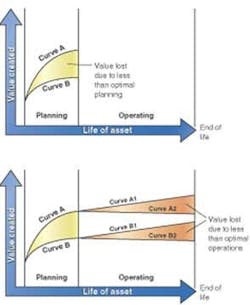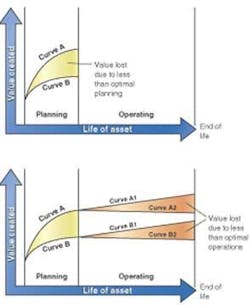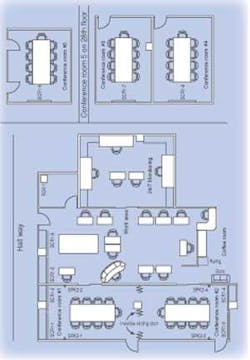Improving drilling decision-making via real time operations centers
Three components that must come together
Nicholas M. Pellerin
Dean H. Kaminski
Douglas M. Dunbar
Wayne J. Crumhorn
Halliburton Sperry-Sun
Glenn R. McColpin
Landmark Graphics Corp.
Jevon H. Williams
Shell Exploration & Production Co.
After running a six-month pilot Real Time Operations Center program in its New Orleans, Louisiana, office, Shell Exploration & Production Co., in cooperation with Halliburton Sperry-Sun, elected to expand the RTOC to include all Gulf of Mexico drilling operations. The pilot was of limited scope but sufficient as a proof of concept. Additionally, it provided many "lessons learned" for the RTOC upgrade project.
Because so much of the value added during the drilling process is impacted by the initial decisions made, a major focus of the RTOC process is to give the center a seamless role in the full gamut of the well construction activity. This means that the RTOC is involved from the planning stage all the way through to the final review of "lessons learned" for all the wells that are monitored.
RTOC layout
The 24/7 monitoring area layout is central to the RTOC. Real-time drilling data is transmitted from the rigs to this section of the RTOC where it is monitored around the clock by drilling optimization specialists. These specialists generally have more than 20 years of rigsite experience.
The work area is the base office space for the drilling engineering and geological assets attached to the RTOC. Much of the planning and modeling activities of the center are conducted here. Conference rooms 1 and 2 are integrated with the RTOC.
null
These rooms are available and frequently used for breakout planning meetings or real-time operational rig meetings, which may require a large participation. The satellite conference rooms are also wired to the RTOC and serve as additional conference rooms when required. At peak usage times, such as the daily morning rig meetings, all the rooms are occupied and in use.
People assigned
The RTOC needs three components to come together into a successful project. These components are the people involved, the technology used, and the processes and work systems set up to employ them.
The roster of people assigned to the RTOC includes:
- Nine optimization specialists (working in shifts to provide 24/7 monitoring)
- A large team comprised of four service company application specialists, two software company asset performance consultants, three oil company-drilling engineers, and one oil company petrophysical engineer (for planning, optimizing, and problem solving)
- A management role for both the operator and the service company
- IT support personnel.
Monitoring
The RTOC groups can be roughly divided into two sections: monitoring and technical support/engineering. Optimization specialists staff the monitoring section, working 12-hour tours on a two-weeks-on, one-week-off schedule. With nine specialists assigned, three are on tour at any one time. The primary focus of the optimization specialists is full time monitoring of drilling and casing activity.
Besides scrutinizing the data for the many warning signs that drilling hazards may emit, the optimization specialists compare ongoing drilling parameters to the expected parameters produced from modeling. Any deviations from the expected signal that well bore conditions must be investigated. The optimization specialists are senior field specialists drawn from both the logging while drilling and surface data logging (SDL) disciplines.
During the planning phase of a well, the monitoring staff is briefed by the individual asset team on the well overviews and section details. They collaborate with the application specialists about borehole related issues. During the execution phase of the well, this staff monitors drilling and casing activity. They maintain contact with the measuring while drilling and SDL field personnel via remote collaboration applications such as "NetMeeting," instant messaging and telephone.
null
The other main section of the RTOC consists of an engineering/applications staff. During the planning phase of the wells, these engineering specialists are involved in all parts of the planning process to aid the asset teams in the design of upcoming wells. In addition to working on the actual engineering design of a well, the engineering/applications specialists review the current work and data flows looking for ways to improve efficiency and reduce risk. The staff may go so far as to recommend that extra work be done in a specific area or that extra data be captured during the drilling of a well. This is done if they have reasons to believe this will reduce non-productive time and or risks.
During the execution phase of the well, the engineering/applications specialists coordinate with the optimization specialists, looking for deviations from the well plan and revalidating designs/models based on these deviations. Adjustments to the models/plans are made in sufficient time to affect the outcome of the operation.
The fact that all personnel have access to consistent and controlled shared data facilitates prompt and unambiguous decision-making. This part of the responsibility is very much an "intervention" role. Non-routine or complex events may require a wider audience meeting that includes the rig-based personnel, the RTOC monitoring and engineering staff, and the relevant personnel from the owning asset team to reach a resolution.
During the post-operations analysis phase of the wells, the engineering/applications specialists work to assist the asset teams in analyzing and understanding problems that may have occurred during the execution phase of the wells. The same software tools and models that were used in the planning stage are used during this process.
This part of the responsibility is very much a "lessons learned" role. One objective is to ensure that problems or mistakes are not repeated. The second objective is to make proven solutions readily accessible to all as pre-qualified inputs in future problem resolutions.
Technology
The underlying enabling technology for the RTOC is a dynamic data management platform, which is integrated to the decision support and engineering platform. The platforms rely on a layered architecture. This starts from lower level components such as sensors/transducers, to higher level components such as real-time controls, process control components, job execution components, job analysis, and finally roll up to service decisions and asset-type decisions.
Various sub-systems are integrated in a way that components can be updated independently of the overall platform. This allows introduction of upgrades to the various modules when needed with minimum effect on the overall system's layout and integration. Various components of the architecture can be distributed to the rig(s) as well as in the RTOC.
The data system, which collects, transmits, replicates, and distributes the data and information, is the specific technology that enables the remote monitoring and mutual interaction between the rigs and the RTOC. In the RTOC itself various components include the computing hardware, software, voice/data/video devices, screen projectors, networks, systems integration, and the physical facility itself.
At the rigsite, a dynamic data management service is employed. This allows data to be collected from the rig contractor and all service companies. This service replicates the data to a server back at the RTOC. A remote area network (such as microwave or V-Sat) is the medium employed to transmit the data between locations.
Which type of device is used depends upon requirements, location, availability and the type of rig. Broadband capability and good network integration are important factors for providing a reliable and dependable connection. The network should be virtually transparent between the rigsite system and the RTOC servers.
Hardware capabilities
The RTOC is outfitted with extensive hardware capabilities. A bank of server computers onshore maintains the data exchange replication from the rigs. These servers are the data repository and allow the information to be visible and available in all the other areas of the RTOC.
The work area is outfitted with an array of workstations to support the assigned staff. A complex video-switching matrix is installed to allow high definition displays throughout the facility. The matrix provides the capability to switch and display images from any of the real-time systems or the engineering workstations. Additional access is available via the secure LANs and WANs of both the operator and the service company. Access to both the UNIX and PC computing environments are provided in all areas of the RTOC.
The facility layout is designed to promote an open, collaborative work environment for a multi-disciplinary team without compromising the need for concentration and abstraction required by the round-the-clock monitoring section.
The functionality of the facility layout is important to the success of the entire process. Glass walls and doors are employed where some isolation is important. These provide a sound barrier while still allowing visibility. Access to the monitoring area is controlled for data security purposes in the case of tight holes.
Processes and work systems
The RTOC enables improved drilling decisions through an integrated well design process that can be broken into five steps: data collation, analysis with visualization, detailed planning, real-time operations, and learning and knowledge transfer.
The first step in the well construction process after obtaining well project/targets from the asset team is to gather all relevant subsurface data. The requirements for detailed well planning are determined and an evaluation plan developed to ensure that the integrated well design process is implemented effectively.
The next step is the analysis of all the elements. This is done with heavy reliance on and utilization of advanced visualization software. Having a common visual model for the subsurface environment that combines offset drilling information (lost circulation, wellbore instability events, pore pressure) and subsurface data (stratigraphic features, faults, bedding planes) is essential for understanding the risks that could affect the delivery of a successful well.
With drilling, geology, geophysical, and petrophysical data all represented in the same viewer, associations can be made between drilling events and sub-surface data which may never have been made otherwise. This can lead to drilling team members asking the geophysicists to interpret horizons that indicate problem zones rather than the traditional producing zones or faults.
Detailed well planning using the RTOC team members collaborating with the asset team takes place to establish the least risk well design. This phase requires that the detailed plan be developed using all of the subsurface modeling tools. This may require that certain models be re-run as the final optimized well design evolves. Several iterations may be required as changes in later stages impact previous ones.
The operations phase of the RTOC process involves the real-time monitoring of the well site operations and the interaction between the rigs and the RTOC. The RTOC ensures that the risks identified in the detailed planning phase are being managed and/or reduced. The data gathered while drilling is compared to the expected model outputs.
Any deviations from design must be recognized when they occur and a reason identified. Corrective action at the rigsite is taken as necessary. The plans can also be updated as new information is acquired. This ensures that the forward plans take advantage of new information discovered during the drilling process.
The layered architecture starts from lower level components such as sensors/transducers, to higher level components such as real-time controls, process control components, job execution components, job analysis, and finally roll up to service decisions and asset-type decisions.
Having delivered the well, it is essential that a post well review takes place to capture lessons learned for the next well or any other well that will be drilled in the future. Review after completing a hole section is also important as data gathered can be used to reduce uncertainties and risks on later sections of the current well.
Analysis and optimization is done to push the drilling envelope on subsequent operations. Generally, the review takes place as soon as practically possible. This is when events are freshest in everyone's memory. Any knowledge gained during the drilling process can be linked to a well in the visualization software so that it is readily accessible during the planning for the next well. The operations team updates any of the interpretation or subsurface models that need to be changed as a result of the data acquired or experiences gained.
Conclusions
Real time operations centers can be used to impact many of the problems faced in the industry today. They provide a means to construct a process, which can deal with the data management problem. They provide a means to leverage the knowledge and expertise of the industry's most experienced personnel. Additionally, the high costs and hazards of drilling operations can be mitigated by a successful RTOC.
The RTOC uses remote data transmission and monitoring technology to remove some highly experienced personnel from the rig site but still give them overview of the drilling process. The technology makes them remotely but concurrently available to many rigs. By collecting a team and using this technology multiple rigs can now have the benefit of the sort of experience level previously only available to select "elite" operations. Barriers that may have prevented an experienced person from being deployed to a rig location are removed by this technology. The work force is expanded and leveraged.
The measures of success for the RTOC include:
- Estimated savings of the interventions
- Current operating trends versus historical operating trends
- Cycle time reduction- showing that the RTOC is a value-adding proposition.
Editor's Note: This is a summary of SPE/IADC 79893.



